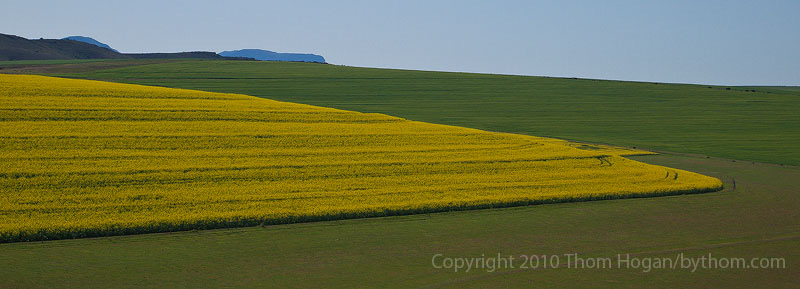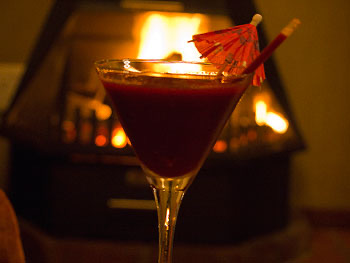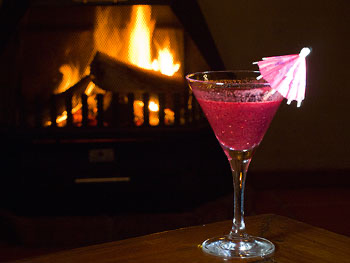Aug 25—On photo workshops that last longer than a week, there are usually one or two days where you're mostly repositioning the group. Today was one of those days. That doesn't mean that we don't photograph--I try to keep photographic opportunities in mind both in the way and time we re-position. It's just that sometimes you just can't avoid a long drive or a short flight. Today was one of those days.
From Franschhoek we climbed up out of the valley and headed over the pass north into farm country. What we were looking for was a canola field in bloom in sunlight, preferably with something interesting to backdrop it. Unfortunately, we were in fog most of the morning. Bright yellow fields that quickly fade into white fog are pretty boring as a photograph. Every now and then we'd see a few trees poking up out of the fog and that was tempting to stop for, but I took a gamble that we'd manage to find something more photogenic. I say "gamble" because for timing purposes we really could only afford a single one hour stop in the fields. Thus, you have to guess at whether each visual opportunity you come upon is the "best" one. You don't want to drive a group of rabid photographers who've paid you money past the best spot to get to one of lesser quality.
Fortunately, we've got one of South Africa's leading photographers, Lanz von Horsten, as our local guide. He's photographed this area extensively, so he not only knows where all the fields are, but can read the local weather patterns. I trusted his sense here, and it paid off when the last couple of canola fields we were to pass were out in sun. The one we stopped at was a bit tricky photographically, though, as there was no obvious "payoff" that the lines in the canola plants would lead to. A few of the fields we had passed in the fog have some great little features that you can use as visual payoffs (but require light); the field we got in the light we wanted forced us to work the more abstract nature of the patterns in the field. As it turned out, it was a useful teaching exercise, and we spent a little more time working the fields than I'd planned.

Here's where Robert was positioned for his shot:

And here's the shot that I decided I liked (a pano, who would have guessed? ;~):

It was in these fields that we had our first real problem of the workshop. With eight people over two weeks, something is bound to go wrong. You work hard to keep that from happening, but it does. Entropy is a harsh mistress. Worse still, we didn't know we had a problem until late in the afternoon, when one of the students realized they no longer had their iPhone.
One thing I do as we pack up at each location (as does Lanz), is to walk the grounds around the vehicle and where most people were photographing. Lens caps, filters, and many other small things--and sometimes big things like lenses if a student changed them in the field--often get dropped or set on the ground and left behind. The problem with the canola was that a lot of the students had gone into the fields (see Robert, above), and many had been down low or even laying on the ground at times. Thus, short of plowing the fields, there wasn't any easy way to do a full ground search as we packed up. In reconstructing events, it is pretty certain the iPhone is in that field and slipped out of a pocket unnoticed. Unfortunately the phone is turned off, so we can't send Lanz back to visit the field while we do something else and have him ring the phone to find it.
We discovered the missing iPhone as we headed into another area called The Heads for lunch (at 3 pm!). But before lunch, we had stopped at one other popular location, where we got our first view of the Indian Ocean:

Here's my view of the same place, taken during my scouting trip:

Note that I've elected to go ahead and include the train tracks at the bottom rather than try to mask them with the foreground foliage. One thing about landscape photography is that there is no "perfect" composition. Robert's shot looks slightly more wild (this is the town of Wilderness, after all), while mine implies something different (would have liked to have a train in the shot, too, but apparently they don't run very often, and usually at times when they wouldn't be in the right light). One of the things that I teach is that you have to be receptive to the attraction compelling you to photograph. Robert and I had two slightly different attractions, and these produce different compositions naturally, despite us being in the same place.
After lunch, we did a tiny bit of photography at the mouth of the inlet at the Heads, followed by some more driving. We finally made it to The Fernery around sunset, our accommodations for the next few days. Besides being a working fernery (yes, ferns), it also contains a small four star resort (it would be five star if it had televisions and Internet access, but we're in the middle of nowhere here, so four star is as good as you can do). We're not roughing it here: individual cabins with tubs and showers that have a view, big comfy beds, private decks overlooking the small creek that winds down to the Indian Ocean, and a central lodge that is spectacular (and serves spectacular food). There's a pool and hot tubs, not that we'll likely get around to using them, but for being at the end of a long dirt road in the middle of a forest, it's a small oasis that gives us a nice comfy base for our local scenic work.
At the lodge before dinner, I pulled a Thom and played a little photography game. If you've got a bunch of photographers in one place, you can play it, too. Simply take a semi-random shot, pass the camera to someone, and have them explain how they'd "improve it." Then have them reshoot it (or do it yourself the way they asked). Pass the camera on again for another set of comments. Keep doing that until you either decide the shot wasn't worth taking in the first place or you refine it to a high enough level that you're all satisfied with it. You never quite know where the game will end up when you start it. But it's always interesting to hear the differences of opinion and talk through them. (You also usually find out who thinks they're the alpha male of the group ;~). I started our game with a simple, but very awkward shot, and it ended with a decent shot. Here's the original (top) and the shot after six iterations by students (bottom):


You can see that there were a lot of small changes (including, believe it or not, changing the logs on the fire). There's still more to do (the umbrella on the drink is over lit and someone has been drinking our subject ;~), but this should give you an idea of where we started and where we were headed with the image.
